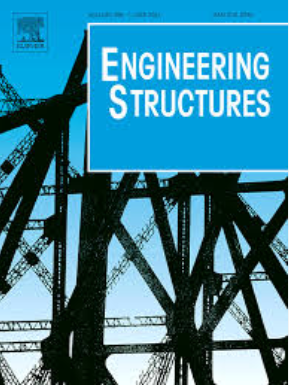Simplified solutions for aeroelastic stability of cable suspended solar panel systems
IF 5.6
1区 工程技术
Q1 ENGINEERING, CIVIL
引用次数: 0
Abstract
This study investigates the aeroelastic instability of cable suspended solar panel systems using analytical and experimental approaches. A simplified procedure for predicting critical velocity is proposed, comprising two closed-form equations for estimating fundamental frequencies and flutter velocity. This simplified procedure enables engineers to quickly assess flutter velocity, allowing for tailoring the structural properties for better design. Wind tunnel tests validate the proposed procedure, with maximum differences falling within 15.6 % in frequency and 15.4 % in flutter velocity. Bimodal coupled flutter occurred at low panel tilt angles of less than 5°, while torsional flutter was mainly observed at high tilt angles above this threshold. Flutter occurred only in the panel when the wind direction was nose-up and was not observed in the nose-down wind direction within the tested range of reduced wind speeds. This is because the cable tension and stiffness greatly increased due to the wind load component in the direction of gravity. Furthermore, wind tunnel tests were extended to multiple-row configurations to explore shielding effects and separation distances between rows. Complex wind-induced vibration phenomena, including flutter, wake buffeting, and vortex-induced vibration, were observed, necessitating further examination.
缆索悬挂太阳能板系统气动弹性稳定性的简化解
本文采用分析和实验相结合的方法研究了缆索悬挂太阳能帆板系统的气动弹性失稳问题。提出了一种简化的临界速度预测方法,该方法由估计基频和颤振速度的两个封闭方程组成。这种简化的程序使工程师能够快速评估颤振速度,从而调整结构特性以实现更好的设计。风洞试验验证了所提出的方法,最大频率差异在15.6% %以内,颤振速度差异在15.4% %以内。双峰耦合颤振发生在小于5°的低倾斜角度,而扭转颤振主要发生在大于5°的高倾斜角度。在降低风速的测试范围内,当风向为机头朝上时,仅在面板上发生颤振,而在机头朝下的风向中未观察到颤振。这是因为由于风荷载分量在重力方向上的作用,索的拉力和刚度大大增加。此外,还将风洞试验扩展到多排配置,以探索屏蔽效果和排间分离距离。观察到复杂的风激振动现象,包括颤振、尾迹抖振和涡激振动,需要进一步研究。
本文章由计算机程序翻译,如有差异,请以英文原文为准。
求助全文
约1分钟内获得全文
求助全文
来源期刊

Engineering Structures
工程技术-工程:土木
CiteScore
10.20
自引率
14.50%
发文量
1385
审稿时长
67 days
期刊介绍:
Engineering Structures provides a forum for a broad blend of scientific and technical papers to reflect the evolving needs of the structural engineering and structural mechanics communities. Particularly welcome are contributions dealing with applications of structural engineering and mechanics principles in all areas of technology. The journal aspires to a broad and integrated coverage of the effects of dynamic loadings and of the modelling techniques whereby the structural response to these loadings may be computed.
The scope of Engineering Structures encompasses, but is not restricted to, the following areas: infrastructure engineering; earthquake engineering; structure-fluid-soil interaction; wind engineering; fire engineering; blast engineering; structural reliability/stability; life assessment/integrity; structural health monitoring; multi-hazard engineering; structural dynamics; optimization; expert systems; experimental modelling; performance-based design; multiscale analysis; value engineering.
Topics of interest include: tall buildings; innovative structures; environmentally responsive structures; bridges; stadiums; commercial and public buildings; transmission towers; television and telecommunication masts; foldable structures; cooling towers; plates and shells; suspension structures; protective structures; smart structures; nuclear reactors; dams; pressure vessels; pipelines; tunnels.
Engineering Structures also publishes review articles, short communications and discussions, book reviews, and a diary on international events related to any aspect of structural engineering.
 求助内容:
求助内容: 应助结果提醒方式:
应助结果提醒方式:


